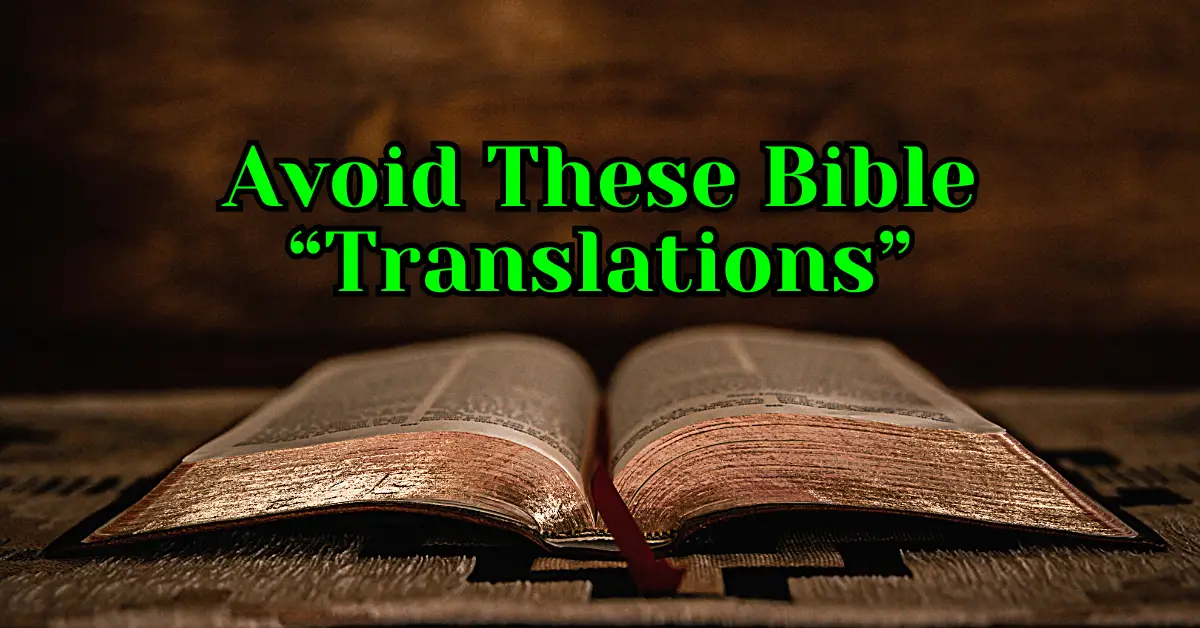Top 5 Bible Translations to Avoid For New Believers in 2025
What are the top 5 Bible translations you should avoid? Why should you avoid them?
When it comes to reading and studying the Bible, your English translation can significantly influence your understanding and interpretation of the text.
With numerous translations available, each with its own strengths and weaknesses, it can be quite a challenge to decide which one to use.
Some translations aim for word-for-word accuracy, while others prioritize readability and contemporary language (aka. thought-for-thought translation).
But you must be warned! Some translations are widely criticized for their inaccuracies and biases.
This article will delve into the top 5 Bible translations you should avoid and provide insights into why they might not be the best choice for your biblical studies.
What Are The Top 5 Bible Translations To Avoid?

As a pastor, having studied the Bible for many years, I am responsible for teaching the Bible accurately and faithfully.
I am also responsible for lovingly caution (and warn) believers about bad Bible translations that could distort their understanding of Scripture.
Unless it is for research purposes, here are the five translations you should avoid using for Bible study.
The Message
A Presbyterian minister and biblical scholar, Eugene Peterson, penned The Message Bible, one of the most contentious translations.
Eugene Peterson wanted to target American English speakers specifically with modern slang phrasing. It heavily relies on paraphrasing the Bible. Thus, this translation grew in popularity.
Yet it has made some mistakes by deviating from literal texts such as Matthew 7:21-22: “[21] Knowing the correct password–saying ‘Master, Master,’ for instance–isn’t going to get you anywhere with me. What is required is serious obedience–doing what my Father wills. [22] I can see it now–at the Final Judgment thousands strutting up to me and saying, ‘Master, we preached the Message, we bashed the demons, our God-sponsored projects had everyone talking.’’
This is in contrast to more faithful interpretations like those found within the English Standard Version (ESV): “[21] “Not everyone who says to me, ‘Lord, Lord,’ will enter the kingdom of heaven, but the one who does the will of my Father who is in heaven. [22] On that day many will say to me, ‘Lord, Lord, did we not prophesy in your name, and cast out demons in your name, and do many mighty works in your name?’”
Such differences have sparked questions about its reliability and potential for misleading readers.
In fact, I do not regard the Message as a Bible translation, but a Bible commentary from the interpretation and opinion of the translator.
New World Translation
This is a corrupt translation of the Bible.
Due to its questionable content, the New World Translation (NWT) has gained recognition among biblical translators.
Authored by individuals connected with the Jehovah’s Witnesses organization, which is a cult, it is notorious for manipulating parts of scripture by adding or deleting words from a passage.
For example, John 1:1 identifies Jesus as ‘a god’ instead of ‘the God,’ unlike other faithful translations.
Unsurprisingly, then, this translation has earned a terrible reputation among scholars and theologians. This shows why NWT isn’t favoured by versions such as King James, English Standard, etc.
Queen James Version
The Queen James Version (QJV) starkly contrasts the King James Bible.
The translation committee or “scholars” of the QJV are unknown, which raises the question of expertise in ancient manuscripts.
It tries to cut out any ambiguity or potential “homophobic” misreadings of biblical texts.
It also attracts criticism due to its approach to dealing with passages related to homosexuality.
This version deletes references that allude to such behaviour in favour of LGBTQ+ acceptance but replaces words and phrases to make them difficult and sometimes hard to understand- something which raises questions about possible misinterpretations given a lack of faithfulness towards the original content.
For example, the QJV translates Leviticus 18:22: “Thou shalt not lie with mankind as with womankind in the temple of Molech; it is an abomination” (QJV, emphasis added).
The Passion Translation
The Passion Translation (TPT) is a version of the Bible translated by Brian Simmons.
Brian is part of the Charismatic Movement that aligns with the New Apologetic Reformation (NAR) ideologies. The Charismatic Movement emphasizes spiritual gifts, such as speaking in tongues, prophesying, and healing. The NAR teaches that there are Apostles in modern-day that function the same way as the 12 Apostles.
However, TPT rewords and rewrites the Bible to fit Simmons’ theology and ideology. According to the FAQ section of TPT, it makes these remarks:
“… the meaning of a passage took priority over the form of the original words. Sometimes in order to communicate the correct intended meaning, words needed to be changed.”
“The Passion Translation is more in favor of prioritizing God’s original message over the words’ literal meaning.”
For example, the ESV translates Luke 1:37: “For nothing will be impossible with God.” The Passion Translation translates that verse this way: “No promise of God is empty of power, for with God there is no such thing as impossibility.”
You can see that Simmons adds to the original words of the Scripture that were not found in the Greek manuscripts.
It is possible that this integration could lead readers astray from the accuracy of Scripture.
The concern is whether conventional understandings remain intact when using the translation.
Christian YouTuber Mike Winger did a series of videos talking about the Passion Translation.
The Living Bible
When choosing a Bible translation, being mindful of potential biases is important.
The Living Bible (TLB), created by Kenneth N. Taylor and written in modern English for readability, has received criticism due to its thought-for-thought or paraphrasing methodology, which can compromise accuracy and the use of inclusive language that may inject cultural perspectives into the text.
Instead of viewing this as a translation, it should be considered a commentary.
How to Choose the Right Bible Translation for You

Deciding on the right Bible translation can be daunting, with so many available.
Once you determine your goal of reading and get advice from authoritative figures like pastors or bible scholars it becomes easier to choose a suitable version.
Whether you are studying for spiritual reasons or academic purposes, how well you comprehend the text depends heavily on what type of translation is used—so make sure to consider any personal requirements when picking one out!
Consider Your Purpose (Bible Study, Devotional Reading, etc.)
When selecting a Bible translation, the purpose of your reading should be considered.
For academic study, translations like New American Standard (NASB), which is known for its accuracy and precision in language usage, would be preferable.
Conversely, if you want to spend time meditating on God’s Word, the more accessible choice, such as The New International Version (NIV) might better suit that need.
Utilizing different Bibles depending on the objective can widen understanding of Scripture and develop communication capabilities.
Thus, it is critical to consider what type one requires before making a selection.
Assess Readability and Comprehension
When selecting a Bible translation, readability is important.
A difficult-to-comprehend text or outdated language can make it hard to understand the passages and even put you off from reading altogether.
For example, the New American Standard Bible (NASB) has been deemed as one of the most difficult translations among word-for-word ones, while the New International Version (NIV), on the other hand, has often been named as one of the easiest since its introduction.
Yet some have argued that this version sometimes strays away from strict interpretation.
Consult with Trusted Sources (Pastors, Bible Scholars, etc.)
When looking for a Bible translation, pastors and scholars of the bible are invaluable sources to refer to.
Their expertise can provide guidance in determining how well it adheres to original texts, what techniques were used during its creation, and whether or not the chosen version is appropriate based on personal circumstances such as study and worship needs.
The English Standard Version (ESV) specifically offers great precision when translating from ancient languages while still being readable for all audiences, so an informed opinion about this type of language could be helpful when choosing among translations available today.
Ensure you get the right choice regarding accuracy paired with readability under your context.
Reliable input should always guide the selection process, ensuring they fully cater to individual necessities effectively.
Reliable and Accurate Bible Translations

Translation philosophy is a big topic, so let’s look into some of the trustworthy and precise Bible translations.
These versions have gained respect for their exactitude to the source material, how easy they are to read, and recognition among churches and scholars alike.
The top-notch Biblical texts that fall under this category include the New American Standard (NASB), English Standard Version (ESV), Christian Standard Bible (CSB), New International Version (NIV) as well as New Revised Standard Version (NRSV).
All these renderings find an excellent balance between accuracy and being comprehensible enough for all levels of readers.
New American Standard Bible (NASB)
The New American Standard Bible (NASB) is a highly respected English Bible translation that strives for the utmost accuracy and faithfulness to the original manuscripts. It follows the philosophy of formal equivalence, meaning words are translated directly to maintain authenticity as closely as possible.
This version originates from the American Standard Version (ASV) released 1901 and thus makes it ideal for those who desire an accurate translation they can use when delving into Bible study more deeply.
The word-for-word approach helps ensure minimal changes while still delivering understandable English text with all details intact – making it one of the most reliable bible translations available today.
English Standard Version (ESV)
The English Standard Version (ESV) was released in the early 1990s with a focus on preserving every nuance and meaning of its source text.
It’s renowned for striking an ideal balance between literal accuracy while still providing readable comprehension, thus making it one of the most reliable translations available when seeking to render scripture into modern language accurately.
This translation approach is based largely upon precise replication, or as close to word-for-word conversion from ancient dialects without compromising readability levels desired by readers today.
Christian Standard Bible (CSB)
The Christian Standard Bible (CSB) follows the translation philosophy of optimal equivalence, which strives to balance readability and accuracy.
It has been updated with modern language while preserving words that are faithful to the original texts for clarity and being suitable for scholars and regular readers.
This bible was first introduced in 2004 under its initial title, Holman Christian Standard Bible (HCSB).
It stands out due to combining precision with familiarity regarding word choices. Incorporating both literal translations combined with terms easy enough to understand at a glance makes this an ideal option regardless of whether you’re reading devotionally or performing study on it academically.
New International Version (NIV)
The New International Version (NIV) is considered one of the best translations for readers who value accuracy and readability.
It attempts to provide a faithful interpretation of the biblical text, closely following its wording while still remaining easily understandable in English.
Although it has been criticized for occasionally straying away from pure translation into areas that demand Interpretation, overall, this version makes an excellent choice due to its commitment to clarity without sacrificing precision with regard to word-for-word representation of international
Understanding Bible Translation Types

Different types of Bible translations exist, each focusing on a particular translation philosophy. Word-for-Word versions seek to maintain accuracy and are faithful to the original text.
Thought-for-thought renditions emphasize readability by smoothing over nuances or simplifying certain complexities.
Finally, Paraphrase editions use modern expression while still conveying all relevant information in an easy-to-understand manner.
Understanding these categories is essential when determining which translation most effectively communicates God’s word for you.
Word-for-Word Translations
Bible translations that use the formal equivalence approach, such as Word-for-Word (literal) translations, focus on accurately representing the original text by translating it word for word and preserving its order. Examples include popular versions like the King James, New King James, or English Standard.
There are many limitations in capturing the exact meaning of certain words from ancient languages, so these literal translations may not always be precise representations compared to their original sources.
Thought-for-Thought Translations
Bible translations can vary in style and focus. Thought-for-Thought translations (also known as Dynamic or Functional Equivalence) aim to replicate the original scripture with modern language, prioritizing conveying its meaning over a strict word-for-word translation.
An example of this type is the Christian Standard Bible, which follows an ‘optimal equivalence’ approach, balancing between thought and word-for-word philosophies.
The New English Translation stands out from other contemporary versions, such as NLT, due to its extensive scholarly footnotes.
Paraphrase Translations
Interpretive translations of the Bible involve re-phrasing passages into modern-day language.
The purpose is to maintain accuracy while rendering a more personal interpretation using contemporary words and phrases.
When translating in this style, there can be an increased risk of errors as they may not convey precisely what was expressed in the source material.
An example of such translation would be ‘The Message’ by Eugene Peterson, which has sometimes been called out for being inaccurate.
The Importance of Translation Philosophy

Interpreting the Bible relies heavily on translation philosophy – determining how well the English version matches its original text and how easy it is for modern readers to comprehend.
Understanding this notion is essential for anyone seeking a profound exploration into God’s Word.
The three primary philosophies in bible translation are the Literal Translation Approach, Dynamic Equivalence Approach, and Paraphrase Approach.
Each has its own set of positives and negatives that affect accuracy and readability when translating.
Literal Translation Approach
Bible translations can be approached in a literal sense, which involves translating each word from the original language into an English equivalent with accuracy as its primary goal.
This method, also known as formal equivalence, seeks to keep things simple while accurately conveying the text’s meaning.
Individuals might prefer this approach when reading scriptures because of how faithfully it transmits God’s Word without any unnecessary fuss or complexity added.
It still preserves all important information but changes expressions and order while keeping the tone intact throughout for easier comprehension.
Dynamic Equivalence Approach
The approach of Dynamic Equivalence in Bible translation tries to impart the original text’s meaning by utilizing modern language and wording. This method calls for readers to put their faith in the translators’ interpretation as they use up-to-date expressions to communicate what was intended.
Dynamic Equivalence implies less focus on translating each word from its source rather than prioritizing conveying comprehension and making it applicable to today’s audience.
It also has the ability to improve readability.
Producing more fascinating translations that are easy for current readers to consume.
Paraphrase Approach
Translating the Bible using a Paraphrase approach involves taking one author and expressing the scripture in their own words.
This sometimes does not involve utilizing original biblical languages as its basis.
The primary purpose is to ensure that modern readers can easily comprehend rather than sticking close to what was originally written with exacting accuracy.
This allows for increased clarity, but an inherent risk is involved: it may depart from precisely conveying content from the initial source language or be coloured by personal opinion.
Examples of Bible translations that use this technique include The Living Bible, The Message, and Phillips’ version.
Frequently Asked Questions

What is the best and most accurate translation of the Bible?
The question of which version provides the most accurate translation of the Bible can be tricky to answer. It all depends on what you deem more important: a word-for-word approach (New American Standard or New King James Version) or readability (New Living Translation, Contemporary English Version). For this reason, it is ultimately up to individuals and their preference for accuracy versus style when choosing which bible text they will consult. Keywords such as ‘the most accurate’ and ‘King James’, combined with versions like the ‘Living Translation’ and the ‘Contrast Translation’, combined with versions like the ‘Living Translation’ and the ‘Contrast Translation’.
What version of the Bible is closest to the original translation?
The New American Standard Bible (NASB) is a translation that closely follows the original texts, making it well-suited for research as its translations are very precise. Its style emulates that of the King James Version but is updated to modern English in terms which have changed over time.
What are the three main types of Bible translations?
Bible translations come in three types – Word-for-Word, Thought-for-Thought and Paraphrase. Each of these provides different amounts of accurate translation to the original text along with the interpretation involved.





















2 Comments
Comments are closed.